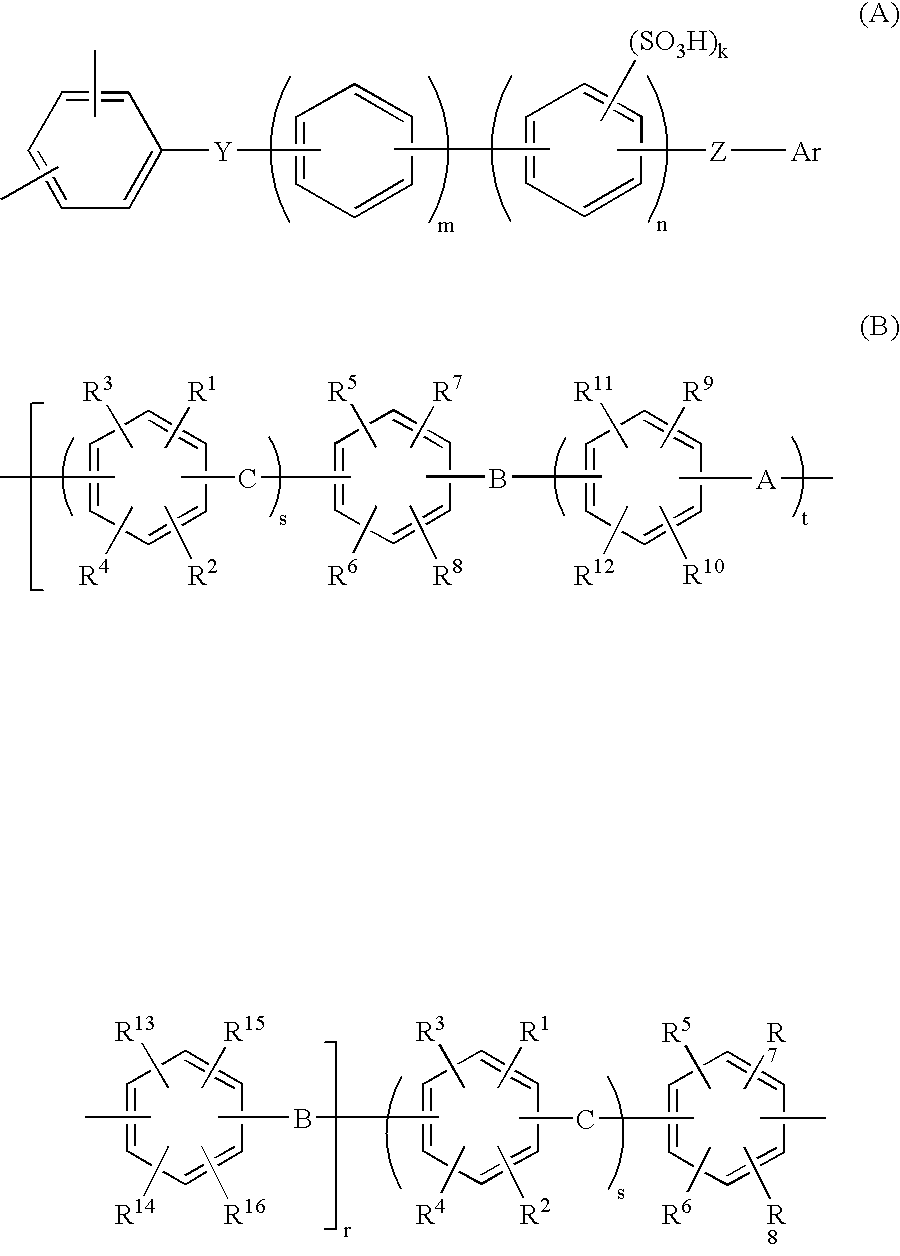Membrane-electrode assembly for solid polymer electrolyte fuel cell
a solid polymer electrolyte and electrolyte technology, applied in the direction of fuel cells, cell components, electrochemical generators, etc., can solve the problems of reducing the power output affecting the efficiency of the fuel cell, etc., to achieve excellent hot water resistance, improve the stability, and improve the effect of power generation outpu
- Summary
- Abstract
- Description
- Claims
- Application Information
AI Technical Summary
Benefits of technology
Problems solved by technology
Method used
Image
Examples
examples
[0100] The present invention will be explained more specifically with reference to examples, which are not intended to limit the scope of the present invention.
[0101] In the examples described below, determinations of sulfonic acid equivalent and molecular weight, preparation of solid polymer electrolyte membranes, production of assemblies of solid polymer electrolyte membranes and electrodes were carried out as follows.
Sulfonic Acid Equivalent
[0102] The resulting sulfonated polymers having sulfonic acid group were washed with deionized water until the washed water became neutral so as to sufficiently remove free residual acid, and then were dried. The polymers were then weighed in a predetermined amount and dissolved in a mixture of solvents of tetrahydro furan (THF) / water; then the solutions were titrated with a NaOH standard solution using phenolphthalein as an indicator and the sulfonic acid equivalent was determined from the neutralization point.
Determination of Molecular...
synthesis examples and examples
Synthesis Example 1
[0113] Into a three-necked flask, equipped with a cooling pipe and a three-way stopcock were weighed 185.3 g (540 mmol) of 2,5-dichloro-4′-phenoxybenzophenone, 15.1 g (60 mmol) of 4,4′-dichlorobenzophenone, 11.7 g (78 mmol) of sodium iodide, 11.8 g (18 mmol) of bis(triphenylphosphine)nickeldichloride, 63.0 g (240 mmol) of triphenylphosphine and 94.1 g (1.44 mol) of zinc, the flask was dipped into an oil bath at 70 degrees C. and purged with nitrogen gas, and then 1000 ml of N-methyl-2-pyrrolidone was added under a nitrogen atmosphere and the reaction was initiated.
[0114] After being allowed to react for 20 hours, the reaction mixture was diluted with 500 ml of N-methyl-2-pyrrolidone, the polymerization reaction liquid was poured into a solution of 1 / 10 of HCl / methanol to thereby make the polymer precipitate, the precipitation was washed, filtered and vacuum-dried, resulting in a white powder. The yield was 153 g. The weight average molecular weight was 159,000. ...
synthesis example 2
(i) Synthesis of Hydrophobic Unit B
[0116] Into a 1 L three-necked flask equipped with a stirrer, a thermometer, a Dean-Stark apparatus, a nitrogen inlet, and a cooling pipe were weighed 29.8 g (104 mmol) of 4,4′-dichlorodiphenylsulfone,
[0117] 37.4 g (111 mmol) of 2,2-bis(4-hyroxyphenyl)-1,1,1,3,3,3-hexafluoropropane and 20.0 g (145 mmol) of potassium carbonate. After purging with nitrogen gas, 168 ml of sulfolane and 84 ml of toluene were added and stirred, and then the reaction liquid was heated to 150 degrees C. and refluxed by use of an oil bath. Water generated through the reaction was trapped in the Dean-Stark apparatus. When water generation fell to nearly zero after three hours, toluene was removed from the Dean-Stark apparatus. The temperature of the reaction mixture was gradually raised to 200 degrees C., stirring was continued for 5 hours, and then 7.5 g (30 mmol) of 4,4′-dichlorodiphenylsulfone was added, and this was allowed to further react for 8 hours.
[0118] The re...
PUM
| Property | Measurement | Unit |
|---|---|---|
| viscosity | aaaaa | aaaaa |
| viscosity | aaaaa | aaaaa |
| pressure | aaaaa | aaaaa |
Abstract
Description
Claims
Application Information
 Login to View More
Login to View More - R&D
- Intellectual Property
- Life Sciences
- Materials
- Tech Scout
- Unparalleled Data Quality
- Higher Quality Content
- 60% Fewer Hallucinations
Browse by: Latest US Patents, China's latest patents, Technical Efficacy Thesaurus, Application Domain, Technology Topic, Popular Technical Reports.
© 2025 PatSnap. All rights reserved.Legal|Privacy policy|Modern Slavery Act Transparency Statement|Sitemap|About US| Contact US: help@patsnap.com



